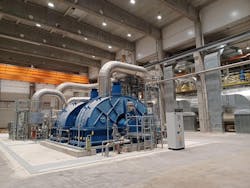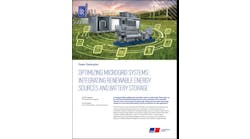Doosan Škoda Power Commissions 270-MW Steam Turbine to Power Wood Pulp Mill in Finland
A new Finnish wood pulp mill is now powered by a 270-MW steam turbine manufactured and delivered by Czech firm Doosan Škoda Power.
The new steam turbine was commissioned by Doosan Škoda Power, the company announced earlier this month. The project at the Metsä Fibre Kemi Bioproduct Mill energizes the plant in its production of pulp from locally sourced wood.
Mill owner Metsä Group is investing deeply in production and efficiency technologies for the Kemi mill which is expected to make about 1.5 million metric tons of softwood and hardwood pulp annually, as well as other bioproducts, according to the release. The pulp total would be twice what the old mill previously produced per year, according to reports.
The massive on-site turbine system could produce 2 terawatthours (TWh, or 2,000 GWh) of renewable electricity per year, powered by biofuels, according to Doosan Škoda Power. This represents close to 2.5% of Finland's total electricity generation. The cleaner bioenergy, as opposed to fossil fuels burned to power the first mill, should significantly reduce greenhouse gas emissions.
The energy efficiency measures being deployed with the new mill and steam turbine include integrated production that optimizes advanced recycling of water and chemicals into the production process. Some of the gases are processed into sulfuric acid, used in the production of pine oil, and thus minimizing waste discharges, according to the report.
Microgrid 2024: The Conference Most Focused on All Things Micro and DER
April 22-24 in Baltimore at the Marriott Waterfront
Diverse Content and Top Leaders Speaking: Register Now and Save Big
Finland's electricity sector is primarily made up of nuclear and hydropower (40 and 18%, respectively), while wood-fueled generation is close to 13% of the mix, according to reports.
Tightly regulated European Union markets can make it difficult to get microgrid projects approved and commissioned, but Finland is seen by some as more open to decentralization of its power sector and also to on-site power, according to a Guidehouse Insights report about the International Symposium on Microgrids held years ago in Australia.
Finland has been considered a global leader in smart meter deployments, while also conducting wholesale and retail electricity markets. Severe grid blackouts in the past decade has motivated some leaders to consider distributed energy and larger on-site power projects, according to the report.








